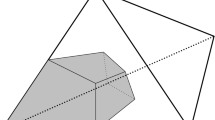Abstract—
The paper presents generalizations of the vector and mixed product concepts including indication of their connection with the fundamental orienting pseudoscalar, necessary for constructing the algebraic Hamilton – Cayley theory for space of arbitrary given dimension n in the pseudotensor case. In existing studies dealing with the mechanics of solids, the case of three-dimensional space is usually considered. The proof of the Hamilton–Cayley theorem is carried out in a pseudotensor formulation. The weight of the pseudotensor is assumed to be an integer. The given examples are tensors of the micropolar theory of elasticity, in particular, hemitropic micropolar elasticity. The dynamic equations for the hemitropic micropolar continuum are discussed in terms of pseudotensors.
Similar content being viewed by others
Notes
In fact, when deriving the Hamilton–Cayley equation, we did not use the concept of the Euclidean metric of the space, which means the validity of equation (3.14) in the case of an arbitrary n-dimensional space
REFERENCES
R. Lakes, “Elastic and viscoelastic behavior of chiral materials,” Int. J. Mech. Sci. 43 (7), 1579–1589 (2001). https://doi.org/10.1016/S0020-7403(00)00100-4
T. Mackay and A. Lakhtakia, “Negatively refracting chiral metamaterials: a review,” SPIE Rev. 1 (1), 1–29 (2010). https://doi.org/10.1117/6.0000003
S. Tomar and A. Khurana, “Wave propagation in thermo-chiral elastic medium,” Appl. Math. Model. 37 (22), 9409–9418 (2013). https://doi.org/10.1016/j.apm.2013.04.029
G. B. Gurevich, Foundations of the Theory of Algebraic Invariants (Noordhoff, Groningen, 1964).
J. A. Schouten, Tensor Analysis for Physicist (Clarendon Press, Oxford, 1951).
I. S. Sokolnikoff, Tensor Analysis: Theory and Applications to Geometry and Mechanics of Continua (John Wiley & Sons Inc., New York, 1964).
J. Synge and A. Schild, Tensor Calculus (Uni. of Toronto Press, Toronto, 1949).
C. Truesdell and R. Toupin, “The classical field theories,” in Principles of Classical Mechanics and Field Theory, Ed. by S. Flügge (Springer Berlin Heidelberg, Berlin, Heidelberg, 1960), 226–858. https://doi.org/10.1007/978-3-642-45943-6_2
N. E. Kochin, Vector Calculus and Foundations of Tensor Calculus (Nauka, Moscow, 1965) [in Russian].
Yu. N. Radaev and E. V. Murashkin, “Pseudotensor formulation of the mechanics of hemitropic micropolar media,” Probl. Prochn. Plastichn. 82 (4) 399–412 (2020). https://doi.org/10.32326/1814-9146-2020-82-4-399-412
E. V. Murashkin and Yu. N. Radayev, “On a micropolar theory of growing solids,” Vestn. Samar. Gos. Tekhn. Univ., Ser. Fiz.-Mat. Nauki 24 (3), 424-444 (2020). https://doi.org/10.14498/vsgtu1792
V. A. Kovalev, E. V. Murashkin, and Yu.N. Radayev, “On the Neuber theory of micropolarelasticity. A pseudotensor formulation,” Vestn. Samar. Gos. Tekhn. Univ., Ser. Fiz.-Mat. Nauki 24 (4), 752–761 (2020). https://doi.org/10.14498/vsgtu1799
O. Veblen and T. Thomas, “Extensions of relative tensors,” Trans. Am. Math. Soc. 26, 373–377 (1924). URL: https://www.jstor.org/stable/1989146.
O. Veblen, Invariants of Quadratic Differential Forms (Cambridge University Press, Cambridgeб 1927).
B. A. Rozenfeld, Multidimensional Spaces (Nauka, Moscow, 1966) [in Russian].
Yu. N. Radaev, “The Lagrange multipliers method in covariant formulations of micropolar continuum mechanics theories,” Vestn. Samar. Gos. Tekhn. Univ., Ser. Fiz.-Mat. Nauki 22 (3), 504–517 (2018). https://doi.org/10.14498/vsgtu1635
Funding
The study was carried out within the framework of a state assignment (state registration no. АААА-А20-120011690132-4) and with the support of the Russian Foundation for Basic Research projects no. 19-51-60001, no. 20-01-00666.
Author information
Authors and Affiliations
Corresponding authors
Additional information
Translated by A.A. Borimova
About this article
Cite this article
Murashkin, E.V., Radayev, Y.N. GENERALIZATION OF THE ALGEBRAIC HAMILTON–CAYLEY THEORY. Mech. Solids 56, 996–1003 (2021). https://doi.org/10.3103/S0025654421060145
Received:
Revised:
Accepted:
Published:
Issue Date:
DOI: https://doi.org/10.3103/S0025654421060145



